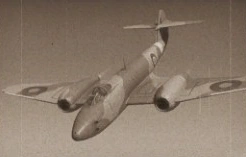The Gloster Meteor F.3 was a jet fighter in service with the British Royal Air Force and Fleet Air Arm. Introduced in 1944, the Meteor F.3 sits at Tier 17, the first jet fighter in the British Line. The upfront cost of is 1,600,000 ![]() .
.
Characteristics[]
The aircraft's development started in August 1940 and was based on previous design work. The Ministry of Aircraft Production drew up the official F.9/40 specifications for a heavy interceptor fighter to be designated as Type G.41. The first prototype fighter flew on March 5, 1943. At the beginning of 1944, the aircraft was launched into full-scale production under the designation of Gloster Meteor F.Mk.I (Type G.41A).
The Gloster Meteor F.Mk.III fighter that appeared in August 1944 became the first full-scale production version of the plane. The F.Mk.III version was to have a pair of Rolls-Royce Derwent Mk.I turbojet engines producing 910 kg of thrust. Furthermore, a number of changes were introduced in the design: the dive flaps were improved, the fuel quantity was increased, and the airframe was partially reinforced. Externally, the F.Mk.III differed from the F.Mk.I by its new cockpit canopy, which was not side-opening but sliding.
The fighter's armament consisted of four 20mm British Hispano Mk.II cannons with 200 rounds per gun in the upper pair and 190 rounds per gun in the lower pair.
A 180-gallon (818 L) fuel tank could be suspended under the fuselage. Two 100-gallon (455 L) external fuel tanks could also be mounted under the wing panels. As an experiment, the suspension of two 500-lb (227 kg) or 1,000 (454 kg) aerial bombs or 16 unguided rockets was attempted.
The first F.Mk.III fighters that left the factory floor in September 1944 had Rolls-Royce Welland engines producing 770 kg of thrust, because the Rolls-Royce Derwents were not yet mass-produced. These planes were designated as the G.41C. The 16th production aircraft was the first to have standard Derwent Mk.I engines. These planes were designated as the G.41D. The last 15 production aircraft assembled were the G.41E version, with extended nacelles designed for the subsequent version of the F.Mk.4.
The Gloster Meteor was the first British production jet fighter and the only Allied jet aircraft to take part in World War II. The first F.Mk.IIIs were delivered to the front in the end of January 1945. Jet planes were considered to be top-secret equipment. A great number of limitations were imposed on their combat use. As a matter of fact, they were allowed only to intercept German planes at the rear of their own forces. Due to the complete supremacy of the Allies' aircraft in the air, the Luftwaffe did not show a great amount of activity, so there was not a single air-to-air fight in which the Meteors participated.
The total number of F.Mk.III Gloster Meteors built was 210.
| |||||||||||||||||
